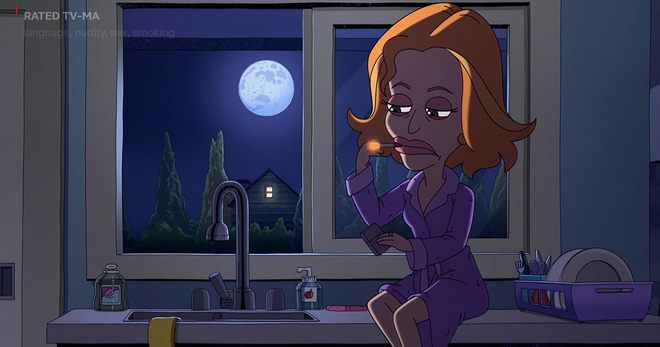5 ways tobacco is normalized in entertainment and pop culture
As smoking becomes less socially acceptable and tobacco use rates continue to decline, entertainment media and pop culture don’t often reflect that reality, putting the nation’s progress at risk.
Tobacco imagery in entertainment continues to portray smoking positively, as a normal social behavior and as glamorous, rebellious and edgy. These images have influence, especially among youth and young adults, who are uniquely susceptible to social and environmental influences to use tobacco. Almost all smokers — 99 percent — start smoking by age 26.
Tobacco in any form of entertainment contributes to the normalization of smoking, and the expansion of the media landscape means that there are more opportunities for exposure. From video games like “Grand Theft Auto” to streaming series like "Stranger Things," here are five ways tobacco is normalized and glamorized in pop culture and entertainment.
1. TV streaming
Tobacco use in streaming shows such as “Stranger Things,” “House of Cards,” “Orange Is the New Black” and “Fuller House” is pervasive, rising and more prominent than it is in broadcast shows, according to a recent report from Truth Initiative®.
Researchers identified 14 streaming and broadcast TV shows most popular among youth and young adults and analyzed them for tobacco imagery. Among the sample, there were nearly 500 depictions of tobacco. The seven Netflix shows in the sample contained more combined tobacco imagery (319) than the seven broadcast shows (139). The study found that, overall, 79 percent of the shows depict smoking prominently.
“While everybody was watching, but no one was paying attention, we’ve experienced a pervasive re-emergence of smoking imagery that is glamorizing and renormalizing a deadly habit to millions of impressionable young people,” said Truth Initiative CEO and President Robin Koval. “Content is the new commercial and it has to stop.”
2. Video games
Many popular video games glamorize smoking, including those rated appropriate for teenagers. For example, in the game “StarCraft II: Wings of Liberty,” the only characters who can do certain tasks, such as operate space construction equipment to raise buildings, are shown holding a lit cigarette in their mouths or behind their ears.
Video game players who participated in a Truth Initiative study reported that 93.5 percent of video games showing tobacco use portrayed it in a positive or neutral light. Participants also said that video game characters can be shown benefiting from tobacco use.
For a Truth Initiative report, “Played: Smoking and Video Games,” researchers conducted video interviews with 44 teen and young adult “gamers.” All 44 recalled seeing smoking in games on a regular basis, with some describing tobacco use as making a character “cooler,” “tougher” or “grittier.”
3. Celebrities
Celebrities have been “unpaid spokespersons” for the tobacco industry for years. On the November 2016 cover of Rolling Stone magazine, music sensation Bruno Mars held a cigarette in his hand. At the 2017 Met Gala, images of celebrities smoking in the bathroom and disregarding New York City’s clean indoor air laws went viral. On Instagram, models Kendall Jennerand Bella Hadid posted stylized black and white photos in which each posed with a cigarette, yet wrote the captions “I don’t smoke” and “I quit.”
“Every post, like and share of a smoking-related image on social media is a free advertisement for Big Tobacco, helping to re-normalize and make smoking cool again,” Koval told Yahoo Style.
4. Movies
Research shows that youth and young adults who are heavily exposed to tobacco imagery in movies are twice as likely to begin smoking as those with less exposure. While movie studios have made some strides in decreasing tobacco depictions over the years, smoking is still present in many youth-rated movies (G, PG and PG-13).
More than one-third of PG-13 movies continue to include tobacco imagery, and the decline in the number of movies with smoking has stalled. The average number of tobacco incidents per movie climbed to historically high levels in 2014 and were nearly as high in 2016.
To help get rid of smoking in movies, Truth Initiative and Trinity Health awarded “Reinvent the Reel” grants to 10 youth-serving groups. The grants come on the heels of a challenge from public health groups to entertainment studios to apply an R rating to movies with smoking by June 1, 2018.
5. Sports
Smokeless tobacco continues to have a cultural association with sports, especially baseball. “Smokeless tobacco use in baseball reinforces the industry’s message that teen boys cannot be real men unless they chew,” said 34 health organizations, including Truth Initiative, in a letter pushing to ban all tobacco products, including smokeless tobacco, at Major League Baseball venues.
California and four cities have banned using smokeless tobacco in their professional baseball stadiums, and three cities have banned using any tobacco product at all their sports venues. Still, more than half of the baseball league — 16 teams — allow tobacco use in their stadiums.
More in tobacco in pop culture
Want support quitting? Join EX Program
By clicking JOIN, you agree to the Terms, Text Message Terms and Privacy Policy.
Msg&Data rates may apply; msgs are automated.



